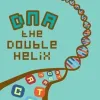Take a look inside 6 images
DNA - The Double Helix
Pros: Easy to learn and fun to play with links to plenty of extended learning resources.
Cons: It's highly targeted so it covers a slice of content that'll require some extra reading and extension.
Bottom Line: Quick and interesting, this is a good starting point for a unit on DNA and genetics.
Teachers can use DNA - The Double Helix as an introduction to DNA and basic genetics, as well as inspiration for learning more about the Nobel Prize and related research. It's perfect for a homework assignment, or for an extension activity for those who finish classwork early. This quickly played game is a great jumping-off point for further study.
DNA - The Double Helix gives students an opportunity to copy strands of DNA by dragging the letters A (adenine), T (thymine), C (cytosine), and G (guanine) into the proper places to make correct base-pair copies. They must do this very quickly because the separated strands scroll off the screen quite fast. Students then use data from the DNA to determine which organism the DNA belongs to by studying background information. They make their decisions based on the best match for genes, chromosomes, and base pairs for the DNA they replicated. Students repeat this process for additional organisms, matching base pairs as quickly as possible, with three or fewer mistakes. Mistakes or omissions are considered mutations.
Students learn the basics of DNA replication and some DNA history through play. A bit more DNA science and genetics history can be gleaned through reading about the nine included organisms. It's a simple, targeted experience that's quickly completed, however. So to get the most out of it, students should read all the text, and when they're done they should visit the website links for much deeper learning. But while the learning in-game is limited, it's done well.














